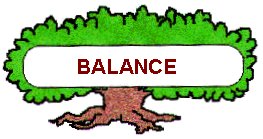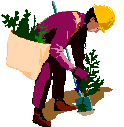

Home Page |
MICHIGAN FORESTS FOREVER TEACHERS GUIDE
| TREE PLANTING TIPS,
FACTS, AND COMMON MISTAKES |
 |
To obtain the best results from a tree planting project, consider the following:
|
 |
Select the Right Species For the Site
| Hardiness Zone Wind Exposure Soil Moisture Soil Drainage |
Soil Texture Soil Fertility Frost Pockets Existing Vegetation |
Different tree species prefer particular soil types and water conditions. Know your soils and lay of the land, and select appropriate tree species. Poor selections will result in trees that are more prone to slow growth, insect & disease problems, and mortality. Growth will always be better where water drainage is good and competition from grasses, brush, and weeds is minimized. Consider these soil and site factors.
Properly Prepare the Site
Site Prep Methods |
Site preparation usually means exposing mineral soil for a planting spot and eliminating or reducing grass, weed, and shrub competition - BEFORE planting. Site "prep" is often done the season before planting. Competing vegetation is probably the most critical factor to control. This sometimes means the use of herbicides.
If you do not wish to use herbicides, consider more work intensive and expensive methods that may not work as well. Furrowing works for a shorter period of time and removes fertile topsoil from the immediate vicinity of the tree roots. Scalping removes a "patch" of sod and topsoil providing a place to plant the tree. Scalping will create a depression with less topsoil and will sometimes "collect" water. Plowing & discing, like a farm field, gives good soil texture for water infiltration and root growth. In lighter soils, wind erosion and excessive dryness might be a problem.
Select Good Nursery Stock
Seedlings are often described as "2-0 stock" or a "3-1 transplant". These numbers refer to the age of a seedling and the growing seasons since transplanting. The first number is the number of years that the seedling grew in a nursery bed. The second is the number of growing seasons since transplanting or root pruning. Total age is the combination of the two numbers. Transplanted stock is more expensive, but generally will experience a higher survival rate. Spruce, fir, and Douglas-fir should be bought as transplanted stock for best results. Pines usually do well as 2-0 stock.
Bare-Root Seedling |
"Bare-root" seedlings have been the normal type of seedling for many years. They are delivered in bundles without much soil on the roots. Bare-root stock is planted in the spring. "Containerized" seedlings are grown in styrofoam blocks. Each "cell" in a styro-block contains a seedling, complete with soil and nutrients. These seedlings, with their soil "plugs", are planted just about any time the soil is unfrozen. Spring and fall are generally the best times. Additionally, these seedlings have not experienced the root trauma of bare-root stock.
Handle the Seedlings Correctly
Signs of Poor Handling |
Improper handling of seedlings is one of the major factors in planting mortality. When receiving your stock, make sure all the packaging is intact. Exposure from broken seals may cause root mortality. Bare-root tops should have a healthy green color (if they’re conifers), a fibrous root system, good stem caliper (diameter), and no multiple stems.
Use a Good Planting & Handling Technique
Bare-root stock are particularly vulnerable to poor care. Keep bags/containers out of direct sunlight and in a cool place. Don’t stack bags/containers. Allow for air movement between bags/containers. Plant bare-root stock as soon as possible. Containerized stock can be more easily stored for periods of time. Water containerized stock if you don’t plant them promptly.
Some Planting Rules |
Remove only enough bare-root seedlings from their bags to plant for that day. If there are left-over seedlings, "heel" them in, which simply means to temporarily bury the root bundle in the soil. While planting, keep bare-root stock in a cool, shady spot and unexposed to air. As little as five minutes can kill critical root hairs and small roots! Keep those bags closed and out of the sun!
 Plant trees at the proper depth, usually at the root collar (a slightly
raised ring where the roots and stem meet). Roots must be oriented straight down in the
hole. "J" rooting will evenually kill the seedling. Don’t wash or rinse the bare
roots. Leave the few soil particles that remain. They are often around critical root hairs
and small rootlets. Carefully carry seedlings so that they don’t dry out or become
excessively rubbed. Make sure there are no air spaces left in the hole.
Plant trees at the proper depth, usually at the root collar (a slightly
raised ring where the roots and stem meet). Roots must be oriented straight down in the
hole. "J" rooting will evenually kill the seedling. Don’t wash or rinse the bare
roots. Leave the few soil particles that remain. They are often around critical root hairs
and small rootlets. Carefully carry seedlings so that they don’t dry out or become
excessively rubbed. Make sure there are no air spaces left in the hole.
Planting Around Homes, Schools, Parks, and Other Human Habitats
For the most part, it is better to plant larger trees because they are more visible and less prone to accidents, such as getting run over with a lawnmower. Balled and burlaped trees are more expensive than bare-root trees, but have more intact root systems and usually have a better chance of survival. Make sure the hole is deep enough and wide enough to accept the entire ball / root system without crowding the roots. The best tree in a bad hole will die. Money is better spent on good planting than on super stock. Plenty of water for the first summer or two is recommended. One inch per week is enough, from either rainfall or a bucket.
Select tree species that live better in human environments (salt, air pollution, soil compaction, etc.). Stake a tree properly. Three lines should be used, with bark protection where lines attach to the tree. In areas of high deer density, cages should be placed around the tree. Cages should be 3-5 feet in diameter and at least five feet tall. Chicken wire can be wrapped around the cage to keep out rabbits. Tree wraps can be attached to the tree stem to reduce problems from mice and voles. Cages might also reduce the threat of vandalism.
Consider the species mix in the area or in your town. Try to avoid planting only one or two species. These "monocultures" could prove to be disaster if an insect or disease agent attacks a particular tree species. Entire neighborhoods could lose their trees, and all the advantages of trees, if monocultures come under attack. This has happened in the past to many communities due to Dutch elm disease, chestnut blight, and emerald ash borer.
Watch For and Provide Follow-up Care
Planting is hard work! You will want to protect seedlings from grass and weed competition until the seedlings are well above the height of grass and weeds. Intensive root competition from sod may impede tree growth for years, even after tree crowns have grown taller than the grass.
Many plantations experience damage from deer, grazing, and fire. These are preventable. Fence construction can be expensive. If you live in an area of high deer populations, consider the cost of a fence BEFORE you order seedlings.
Inspect the seedlings several times each summer for signs of insect and disease problems. Discover the reasons for broken leaders, off-color foliage, unusual growths, and defoliation. Consult a foresteror or an arborist for diagnoses.
Common Mistakes That Kill Tree Seedlings
| Care Errors
Wind exposed roots Planting Errors Soil packed too loosely Other Errors Improper spacing (many potential long-term problems) |
|
|
| Activity Suggestion PLT Plant A Tree |
 |
This website was developed and created by Michigan State University Extension for the teachers of the State of Michigan. |